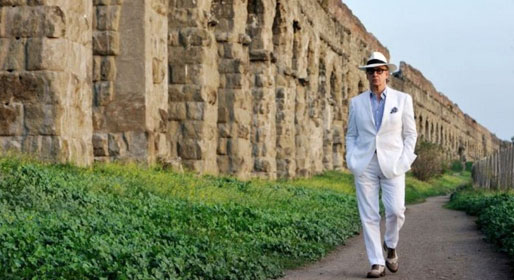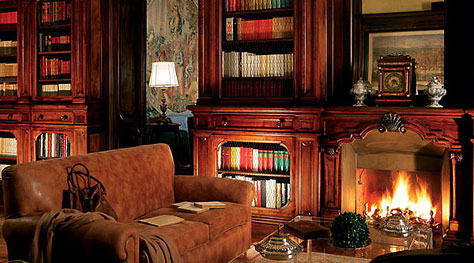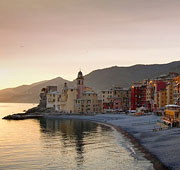The great beauty of Rome
An Oscar winning film and the beauty of the eternal city
"It's a film about Rome, about the love for this city, it's a film in love with my country". What better way to celebrate Paolo Sorrentino's Oscar for Best Foreign Language Film than with a tour of Rome, visiting the ten historic sites featured in his The Great Beauty?
La Fontana dell'Acqua Paola
La Fontana dell'Acqua Paola is located right on the top of the hill of Gianicolo. Built in imposing baroque style, this massive marble monument is known locally as the "Fontanone" or giant fountain.
Sorrentino's film - after long tracking shots over the city - begins here, with a female chorus and a tourist who faints, as if overcome by such immense beauty.
Museo Etrusco di Villa Giulia
The Sarcophagus of the Spouses, the Pyrgi Tablets, the Apollo of Veii, the Cista Fircoroni and a reconstructed frieze displaying Kreugas eating the brain of his enemy: just some of the pre-roman treasures waiting to be discovered in the Etruscan Museum, housed within the walls of Rome's Villa Giulia.
National Etruscan Museum of Villa Giulia: Skip The Line
See fascinating remnants of Etruscan civilization with an audio guide. Discover Etruscan and pre-Roman treasures.
Get your tickets now!
Giardino degli Aranci
One of the most romantic gardens in Rome, the Giardino degli Aranci is located high up on the city's Aventine hill. Look through the keyhole in the gate of the Priorate of the Knights of Malta, located in Piazza Cavalieri di Malta, and you can see the cupola of St Peter's framed by a beautiful display of orange trees.
San Pietro in Montorio
A small and perfectly symmetrical, cylindrical-shelled temple in the courtyard of the Church of San Pietro in Montorio, the Temple of Bramante, was one of the first works of high renaissance architecture in Rome.
Terme di Caracalla
Sorrentino chose a giraffe as the Fellini-esque protagonist of the scene set around these incredibly well conserved Roman baths. The Baths of Caracalla were the largest public baths in Rome, until Diocletian built his....
Baths of Caracalla
Visit the best bath in ancient Rome, constructed under the Emperor Caracalla and finished in 216 A.D. Explore all 25 hectares of Rome's best preserved ancient spa.
Get your tickets now!
Musei Capitolini
The Capitoline She-Wolf, thought to date back to the 5th century B.C and the symbol of the city, is jealously guarded within the walls of the Musei Capitolini. Believed to be the world's first museum, the Capitolini first opened its doors to visitors in the 15th century.
Capitoline Museum
See a treasure trove of items relating to the history of Rome itself.
Get your tickets now!
Palazzo Braschi
Sporting imposing vaulted ceilings, columns and marble stairs, the neoclassical Palazzo Braschi is situated in the oldest part of the Italian capital between Piazza Navona, Campo de' Fiori, Corso Vittorio Emanuele II and Piazza di Pasquino. One time political headquarters of Mussolini, after the second world war the palazzo was use as a shelter for 300 refugee families.
Palazzo Braschi - Museum of Rome
Get into this Neoclassical museum tracing the history of Rome. There are 18 red granite columns originally used by Emperor Caligula.
Get your tickets now!
Palazzo Altemps
Another historic palazzo situated slap bang in the center of Rome, within steps of Piazza Navona, Palazzo Altemps now houses a Museum of Ancient Roman and Greek art.
Palazzo Altemps
Admire ancient artwork at one of four National Museum of Rome sites
Get your tickets now!
Parco degli acquedotti
One of the many green spaces in central Rome, the Parco degli Acquedotti is named after the Ancient Roman aqueducts which pass through it. A public park since the 1960's, it's here that the film's protagonist Jep watches a group of performance artists at work.
Villa Medici
The itinerary draws to a close on Rome's Pincian hill, between the Trinità dei Monti and Villa Borghese, at the Villa Medici. Founded by Ferdinando de'Medici in the mid 1500's, in the 19th century the villa became the seat of the French Academy. The gardens, often used as outdoor venue for events and festivals, are among the most beautifully maintained in the capital.
Itineraries
Main destinations
Hotels in the area
- Useful links
- Rome
- Rome Hotels
- Rome (all hotels)




















